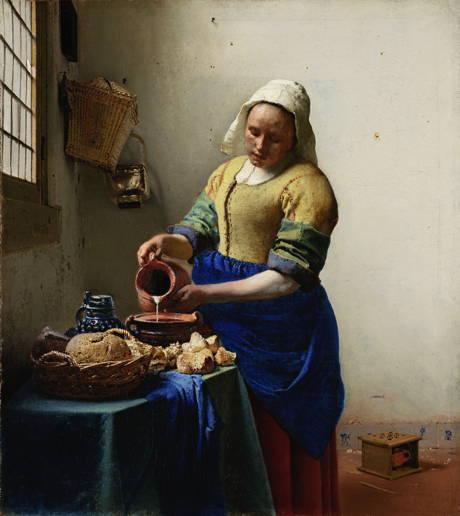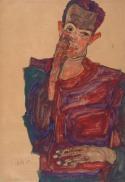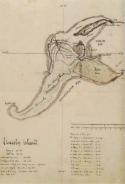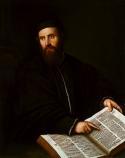Art Of The Day Weekly
#461 - from 23 February 2017 to 1 March 2017

Johannes Vermeer, The Milkmaid, c. 1660, oil on canvas, 45.5 × 41 cm, © The Rijksmuseum, Amsterdam.
IN THE AIR
Vermeer, the rarest painter in the world
PARIS - Certain retrospectives create a true tsunami. For example, the one on Matisse at the Grand Palais in April 1970 showed 210 paintings. For the one on Picasso, in 1966, the works shown between the Petit and the Grand Palais – including paintings, drawings and work in ceramic– nearly one thousand were displayed. When it comes to Vermeer, the Louvre limits the exhibition to twelve paintings. This is not due to any lack of interest or to any shyness on their part. It is simply because there are only 36 works attributed to Vermeer in the world. Some specialists stop at 35! So actually it is quite a feat to have brought together one third of his works, which are scattered and zealously protected by their owners. It seems very difficult to equal the success of the Mauritshuis museum in The Hague when it managed to display 23 paintings. As a matter of fact, Vermeer is in good company at the Louvre, since the aim of the exhibition is to show that he was not a solitary genius, but rather a painter who was well aware of the ideas of his time and of the work of his colleagues. His paintings are grouped into themes –woman with a letter, woman with a mirror, female musician, etc. – and mingle with works by Metsu, Dou, Van Mieris, etc. The “sphinx of Delft” as he was named by Thoré-Burger who rediscovered him in the 19th century, was simply an interpreter in a broader current. But an exceptional one.
• Vermeer et les maîtres de la peinture de genre at the Louvre, from 22 February to 22 May 2017.
EXHIBITIONS
Bellini, inner peace
CONEGLIANO – Italy overflows with hidden treasures. Who has ever heard of the Accademia dei Concordi in Rovigo, an anonymous town in the delta of the Po River, except for the fans of soprano Katia Ricciarelli, who is a native of the town? The proximity to Venice helped it be an unexpected repository of the great art of the Renaissance. The collection of the Accademia is the perfect point of departure for an overview of the production by Giovanni Bellini (1430-1516), whose 500th death anniversary was just honoured. The viewer cannot but wonder how he and his disciples, many of which are present here such as Marco Previtali, Marco Bello and Jacopo da Valenza among others, gave landscapes, the figures of Saints and even portraits this type of philosophical grace, as if in “suspended time”. In contrast to our constant daily rush, this “alternative” has a unique taste.
• Bellini e i belliniani, at Palazzo Sarcinelli, from 25 February to 18 June

Egon Schiele, Self-portrait pulling down an eyelid, 1910, Chalk, brush, watercolour, opaque colour on brown wrapping paper, Albertina, Vienna
Schiele, one hundred years
VIENNA – The exhibition wishes to present him as the most important drawer of the 19th century. Even if Picasso or Dalí could object, this pretention is not totally unfounded. Egon Schiele died very young, at the age of 28, from the Spanish flu. But he found the time to leave a permanent mark on Viennese and European art. His drawings are strikingly varied - nudes that at times are openly erotic, portraits, landscapes composed at times like marquetry, as well as flower bouquets of anchored ships – and make up 90% of his production. His style combines a raw trait to areas of sfumato, monochrome highlighted by touches of bright colour and is immediately recognizable. To honour the centennial of his death, the Albertina presents some 150 works on paper, most of them from its collection.
• Egon Schiele at the Albertina, from 22 February to 18 June 2017.
Bury, permanent motion
BRUSSELS - Pol Bury (1922-2005) is one of the actors of kinetic art. One sometimes has to bend backwards to find an imperceptible movement among his large wood paintings. This globe-trotter (Paris and New York where Yul Brynner left unforgettable photographs of his work), he is now back, close to home – he was a native of La Louvière, between Mons and Charleroi.
• Pol Bury, Time in Motion at Bozar, from 24 February to 4 June 2017.
Koudelka, what exile means
PARIS – The world has never had so many refugees and they have never been so unwelcomed. The title and the content of the series the Centre Pompidou presents, by nomadic photographer Joseph Koudelka (born in 1938), of Czech origin, once stateless and currently French, encourages us think about this.
• Josef Koudelka, la fabrique d’exils, from 22 February to 22 May 2017.
50 years of Rancillac
PARIS - Bernard Rancillac (born in 1931) is an independent figure of the New Figuration movement. Since the sixties he has dissected the avalanche of images the media pour out. At a time when real and false are more than ever confused in this big whirlwind, his non-conformist analysis – presented here in some one hundred works - has a corrosive virtue.
• Bernard Rancillac at Espace Niemeyer, from 21 February to 7 June 2017.
OPENINGS OF THE WEEK

ODY SABAN & FRANÇOIS JAUVION
23 February 2017 - PARIS - Galerie Hervé Courtaigne
Two powerful and colourful universes
AUCTIONS

Lot 76: Hand-drawn map, done by Jules Verne in 1874 for the L'Île mystérieuse and representing Lincoln island. Estimate: €100 000 - €150 000. Courtesy SVV Boisgirard-Antonini.
Jules Verne on his island
PARIS – The Hetzel publications with their unique bindings, movie posters with the Russian star Ivan Mosjoukine (whom Romain Gary held was his father) as Michel Strogoff, a translation in Pashtun, and a globe in wax paper: a Jules Verne sale always makes us travel. This one includes oddities such as a report of the surprising claim the inventor of the explosive melinite, Turpin, made in 1896 against the novelist who supposedly described him as an absent-minded scientist in one of his books. The most important object of the auction is a map of the Mysterious Island, drawn by Jules Verne himself in 1874, in a totally English version in the beginning, with its Washington Bay, its Franklin Mount, its Shark Gulf and its Serpentine Peninsula. Contrary to Victor Hugo, Jules Verne is not known to have left many drawings made by him. This one, estimated at €100,000 €, could therefore reach an exceptional price.
• Jules Verne, le musée Weissenberg, at Drouot-Richelieu (Boisgirard-Antonini) on 1 March 2017.
A record for Magritte?
LONDON - While Rotterdam bowed to Dalí, Masson and Brauner (see our newsletter dated 9 February, http://www.artaujourdhui.info/art-aujourdhui-hebdo-00968.html) and Magritte, after his success at the Centre Pompidou, gives an encore at the Schirn in Frankfurt, the auctioneers at Christie’s offer an interesting selection of Surrealist art, with some major artists. The work by Max Ernst for instance(Portrait érotique voilé) was the property of New York gallery owner Julien Levy before being bought by the poet Gilbert Lely, the author of an important biography on the marquis de Sade. Magritte himself should set a new record with La Corde sensible, a large oil painting from 1960, estimated at £14 million.
• The Art of the Surreal at Christie’s, 28 February 2017.

